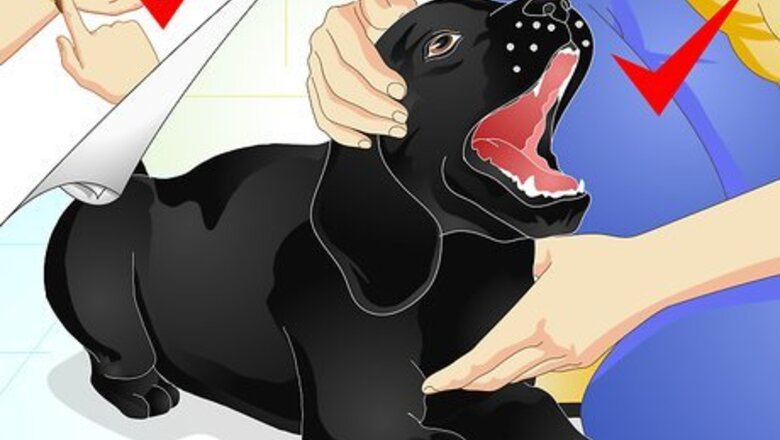
views
Potty Training Your Dog
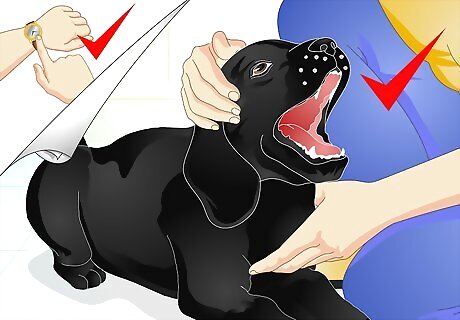
Make sure you have enough time and patience. Raising a well-trained and well-behaved dog takes time and commitment over many years. Before you get yourself into this undertaking, you should think about your schedule and if you have time for a puppy. Your puppy will also take time to learn new commands, so be patient with him as he learns. Your puppy will not know how to be well-behave naturally. However, he will want to please you, which will help you when you train him. Potty training can take anywhere from four to six months to a year.
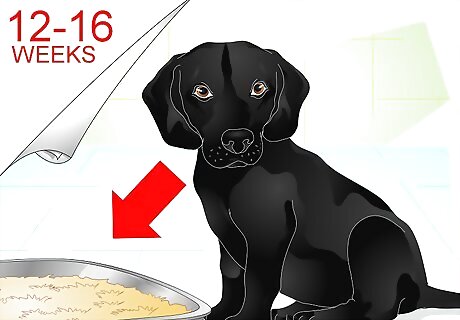
Start at the right time. Your puppy can begin to be potty trained when he is around 12 to 16 weeks old. At this point, his bladder is developed enough that he can learn to hold it.
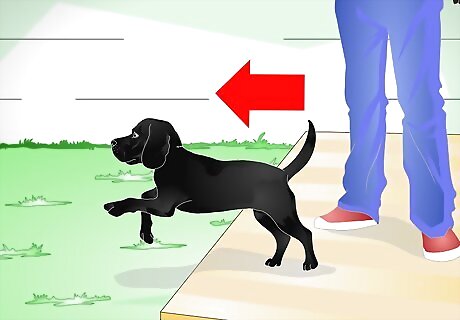
Take him out immediately. Once you bring your new puppy home, you need to take him outside immediately to show him where he needs to go to the bathroom. This will help him start associating being outside with going to the bathroom. Once he does, give him lots of praise and affection, which will link praise with going to the potty outside. When he goes out, let him sniff and explore the yard until he goes to the bathroom.
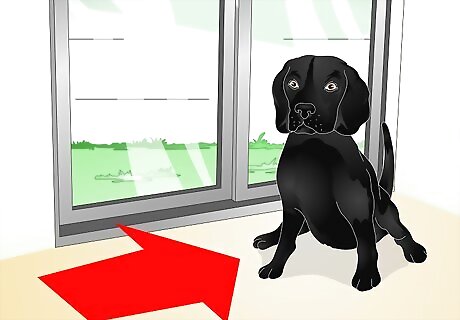
Confine him to a small area. When your puppy is first potty training, you need to make sure he is confined to one general area when you aren't home or watching him. This will cut down on accidents in other parts of the house while he learns. Common places are washrooms and bathrooms.
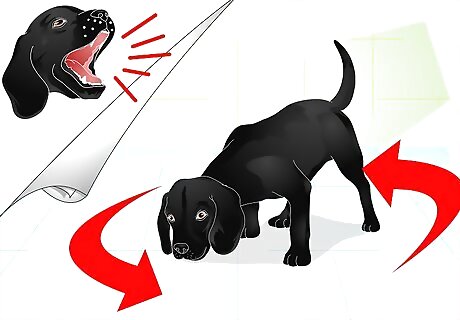
Watch for signs of potty time. Your puppy will show signs that he needs to go out. Look for signs of panting, pacing, sniffing around, or barking. These are all signs that he needs to go to the bathroom. When these signs appear, take him outside right away so he can do his business.
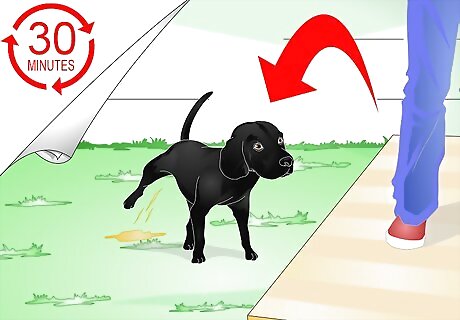
Create a tight schedule. When your puppy is learning, you need to take him out often. Take him out right when he gets up and every 30 minutes to an hour throughout the day. Take him out right after feeding and when he wakes up from a nap. He should also go out right before he goes to bed. Try to take him to the same spot in the yard every time you take him out. His scent there will prompt him to go to the bathroom. His size may play a role in the timing of when he goes out as he ages. If your dog is small, he has a smaller bladder and will need to go to the bathroom more, even when he is grown. This may make it seem like he can't hold it, but he is just smaller.
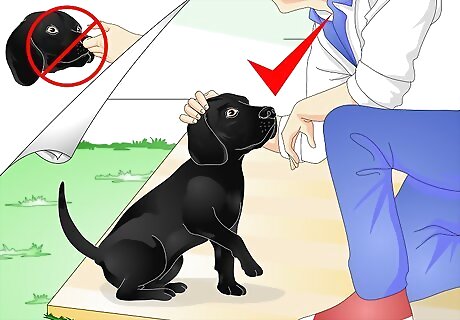
Give plenty of praise. When your puppy goes out and uses the bathroom, give him a lot of praise. You can even go overboard with how much you praise him. It will only make him want to please you more. You can even give him a treat every couple of times you take him out. Rewards like treats and praise will help reinforce your dog's good behavior. Never wipe his nose in it if he has an accident in the house. This is cruel and will not teach him anything.
Crate Training Your Puppy
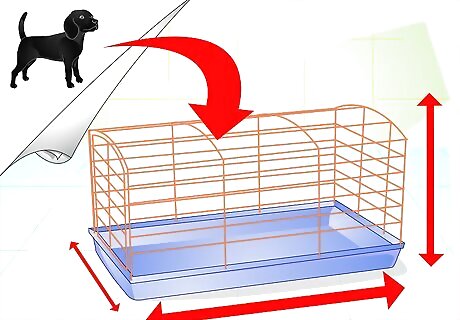
Pick the right size. Crate training is a great thing for your dog. You can put him in there when you aren't home, which will cut down on accidents in the house. It will also allow him a place to escape to when he is overwhelmed by everything or just needs to be alone. Since he will be spending significant time in his crate, you need to make sure you buy one large enough for your puppy. His crate, also known as a kennel, should be large enough that he can stand up, turn around, and comfortably lay down in. It should also have plenty of room to fit him as he grows.
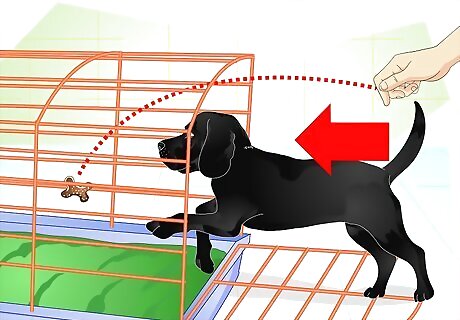
Encourage him to go inside. When you are first crate training your dog, you need to make it a comfortable and happy place for him. Start out with the crate open in your living room or kitchen where you are. Place a blanket, small bed, or crate pad in the crate to make him want to go in. You can also toss in a treat to encourage him inside.
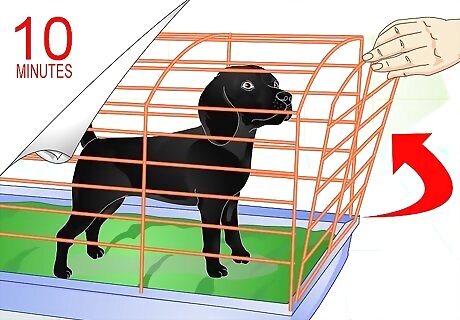
Shut the door on him. Once you send your dog into the crate with the door open for a few times, start shutting the door while he is in there. Leave the door closed for about 10 minutes. You should not let him out if he is still whining or scratching at the door of the cage. This will show him that this behavior will get him out of the cage.
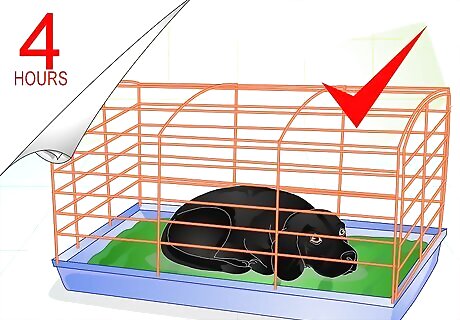
Increase the time in the crate. Over time, you should increase the amount of time you leave your puppy in the crate. Keep increasing the time he spends in the crate until he can stay in the crate for long periods of time without whining or pawing at the door. This will vary depending on how old your puppy is. If he is under four months old, the time he needs to stay is two hours. If he is older than four months old, he needs to stay in there four hours without whining, as long as their bladders can hold it that long. Never leave a dog in a crate for longer than this, unless he stays in his crate while you are at work. Never use the crate as a punishment because he will start seeing it as a scary place.
Socializing Your Dog
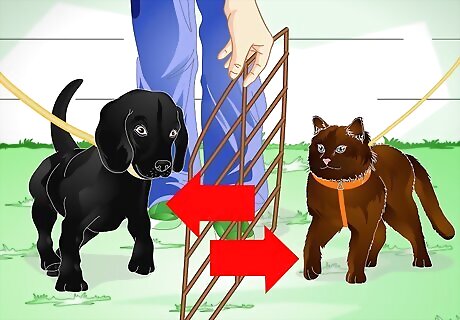
Introduce him to your other animals. If you have other dogs or cats in your home, you need to take your time introducing your new puppy to them. When you first bring your puppy home, keep him separate from your other animals. For their first meeting, find neutral territory, such as a neighbor's yard, a park, or other open space. There also needs to be a fence or other open but restricted barrier there so you can keep the animals apart. Put a leash on all the animals and then put your new puppy on one side of the fence and your other animals on the other. Let them sniff each other through the barrier for around 30 minutes. The next day, take them back to a neutral location and let them meet without the barrier. This area needs to be open so they won't feel confined and will have plenty of room to sniff each other. Wait around two minutes while they sniff each other, letting them get used to each other. Watch them carefully for any aggressive behavior or fighting. After the initial sniffing, let them play for a few minutes, then take them back home. After this, let them together in your backyard, then in your house. For the first few weeks, don't leave them alone together in the house. Wait until you know they are familiar enough with each other until you do that.
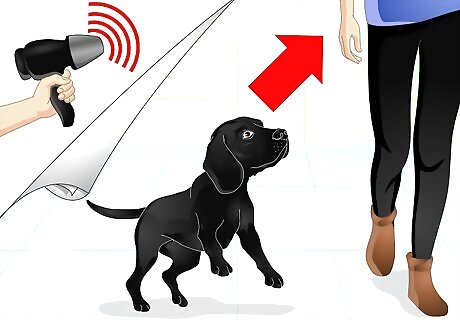
Acclimate him early. In order for your dog to be well adjusted, you need to get him acclimated to household noises and activity and other people. This will help him get used to them while he is still growing, which will help him not react badly to them as he grows. You should do this in a non-threatening manner. Don't scare him with things, such as chasing him with a vacuum or hitting at him with a broom. Just go about your daily business so he gets used to it. Slowly introduce him to the other animals in the house as he grows so he gets used to them. Make sure any visitors you have over are introduced to your puppy so he learns to like new people.
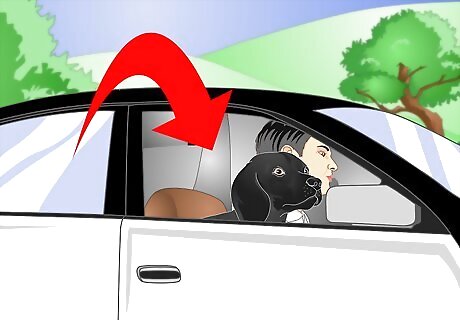
Take him for rides. In order for your puppy to get used to being in the car, you should take him for a lot car rides. This will get him used to other vehicles on the road and the noises of the drive. This will also help him be easier to travel with and easier to take to the vet.
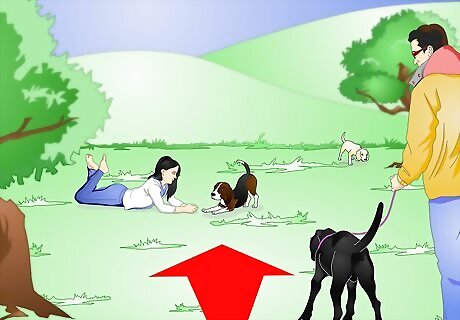
Go to the dog park. Dog parks are great places for your dog to be socialized with other dogs as well as humans. When you go to the dog park, make sure your puppy is on a leash. You don't want him to run away or get in trouble with other dogs. Make sure your puppy has had his first two distemper vaccinations before you take him to the park. Only let your dog off the leash if he likes other dogs and humans, if he has learned to stay near you, and if he listens to commands.
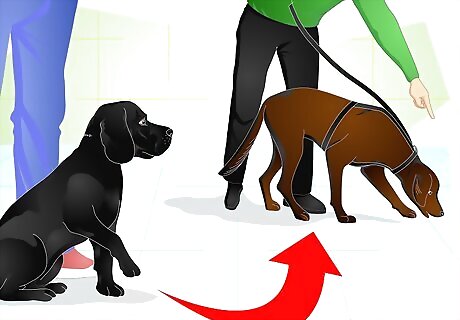
Go to obedience classes. Once your dog is a little older, you can start taking him to obedience classes. These are given by pet stores, community centers, or pet shops. These classes will help you learn along with your dog how to get him to obey you and be a well-behaved dog. If you can't find any classes you like, ask you vet.
Training Your Dog with Voice Commands
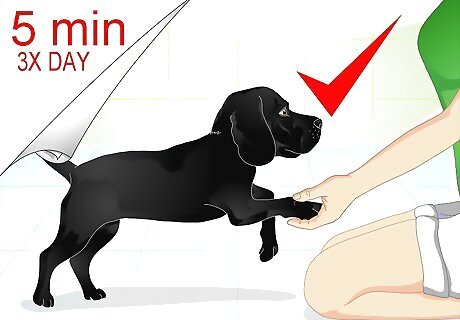
Start with short sessions. Training your dog with voice commands will help him be a better and well-behaved dog throughout his life. When you are first start training him, keep the sessions short, around five minutes. You should also start with one command at a time until he learns it. Then move on to another command. Repeat these sessions three times a day as you are training him. You can increase the time of these sessions as he gets older.
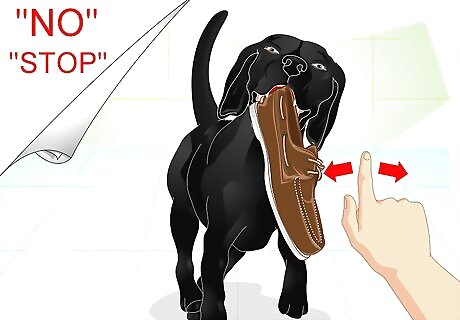
Teach him 'no' or 'stop'. The first lesson that your puppy should learn is 'no' or 'stop'. It will be easier for you to pick one or the other, since they basically mean the same thing and your dog will not know the meaning until you teach him. Make sure you are always firm with this command, though you should never hit him. When you see your puppy doing something he shouldn't, tell him 'no' or 'stop'. Then pull him away from the activity and tell him again. Keep repeating this command every time he does something he isn't supposed to until he obeys you consistently.
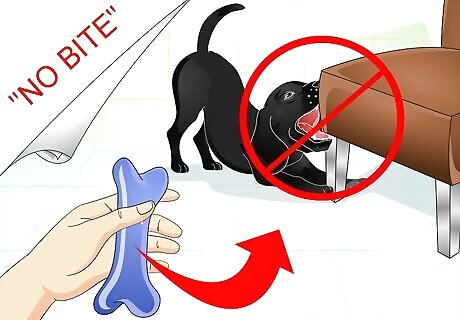
Train him not to bite. Your puppy with start to explore the things around him through his mouth. This means that he will try to chew and bite everything. When you are playing with you puppy and he goes to bite or chew on you, tell him 'no bite'. After you say this, give him a chew toy to chew on instead. This will help him associate this behavior with the toys instead of your fingers. Do the same thing if you find him chewing objects he shouldn't, such as shoes or furniture, by saying 'no chew'. Repeat until he does this consistently.
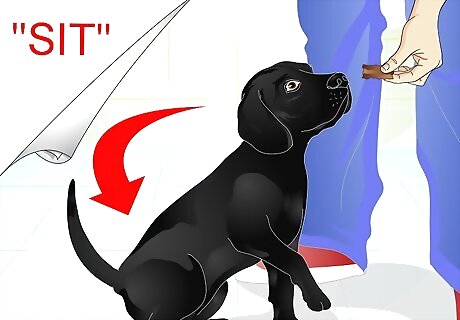
Teach him to 'sit'. One helpful command to teach your puppy is 'sit'. To start off, stand in front of your puppy with a treat in your hand that he can see. Firmly tell him to 'sit', then push his bottom down until he is sitting. Once he is there, give him the treat and praise him. Turn away from your puppy and let him stand back up. Then, turn back to him and tell him to sit. If he doesn't, repeat the command and push his bottom down gently. Keep doing this until he can do it on his own without your help consistently. This command works well to stop her from jumping as well. Use a leash or your hands to gently pull him back, then give him the sit command and a tasty treat when he complies. He will soon learn that he shouldn't jump.
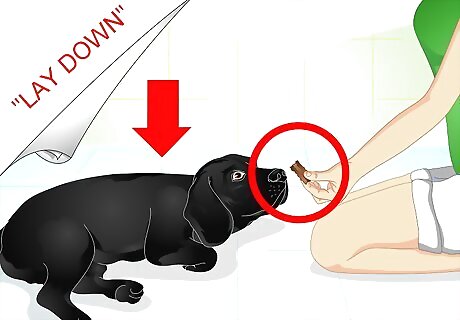
Train him to 'lay down'. Once he has mastered many of the other commands, you can teach your dog to lay down. You can either say 'down' or 'lay down' for this command. To start, stand or sit facing your dog with a treat in your hand he can see. Tell him 'down' or 'lay down' as you move your hand with the treat down towards the floor. As he starts to lay down, even if it is only a little bit, give him the treat and praise him. Keep trying until he lies down completely on the floor consistently.
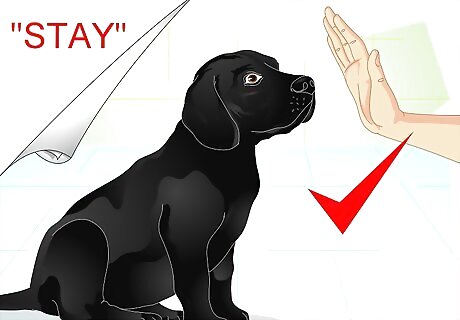
Teach him to 'stay'. The 'stay' command is one of the best to help with your puppy's safety. When your puppy is sitting in front of you, hold your hand in front of his face as wide as you can and firmly say 'stay'. Start backing away slowly. If he starts coming towards you, command him to sit again and give him praise. Then repeat the process until he stays on his own, then praise him and give him a treat. Keep doing this until he learns to stay all the time, even if you go far away and tell him to 'stay'.
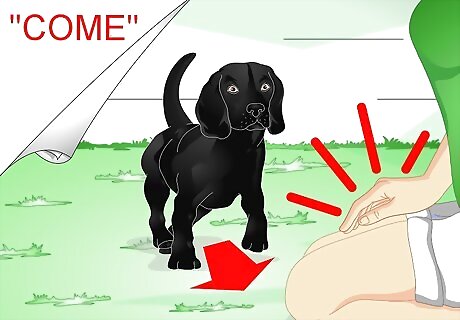
Train him to 'come'. Another command that can help your dog stay safe is 'come'. Start out slow while you are playing in the yard. Lean down and slap your thighs, saying 'come' in a friendly voice. He will think you want to play, so he will come running to you. Give him a treat a praise. Repeat this command at different times, especially when your puppy may be distracted by a toy, another dog, or another human. Repeat the command and praise him when he comes to you. You can also try using one of his favorite toys to entice him to you in the beginning.
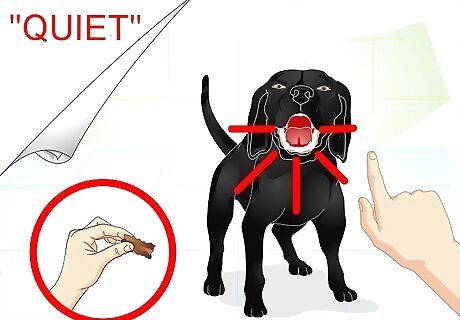
Teach him to be 'quiet'. This command helps you stop your dog from barking at the wrong times. Keep a bag of treats handy for when he starts barking. When he does, look at him with a treat in your hand and say 'quiet'. As soon as he stops barking, give him the treat and praise. If he doesn't stop right away, show him the treat to try to get him to stop. Then repeat until he stops as soon as you say the command.
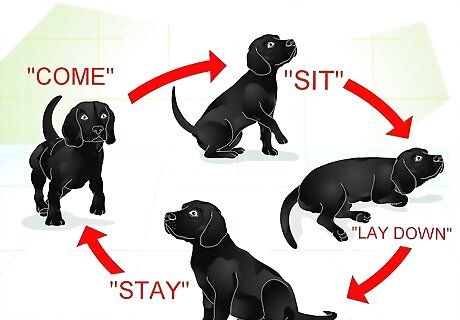
Keep up the training. As your dog ages, make sure to keep his training steady. Even after he learns all the commands, play with him and call out random commands. When he does as he is told, give him praise and treats. This will keep him sharp and make him a better, more well-behaved dog as he ages.
















Comments
0 comment